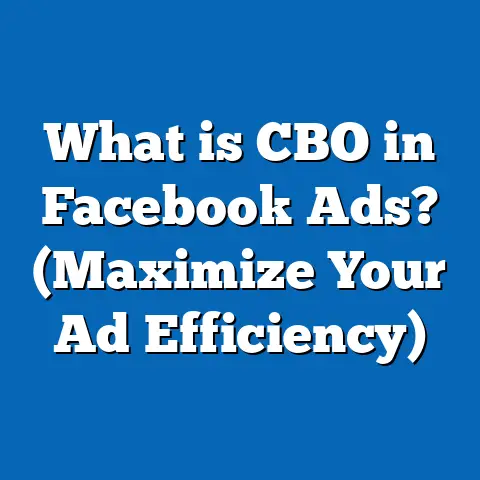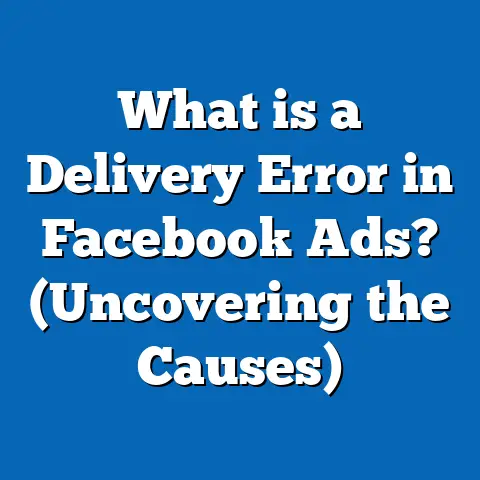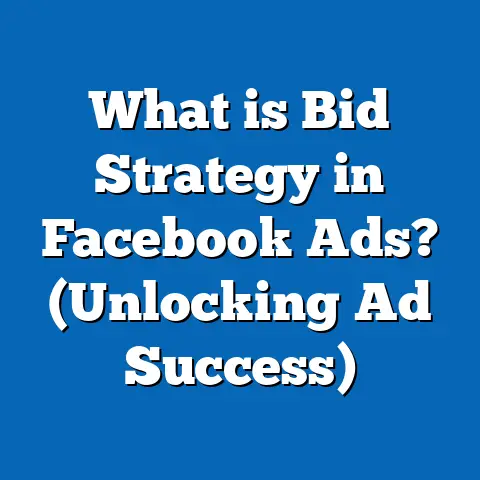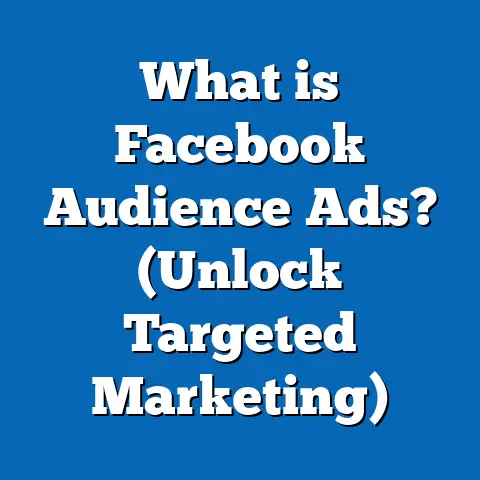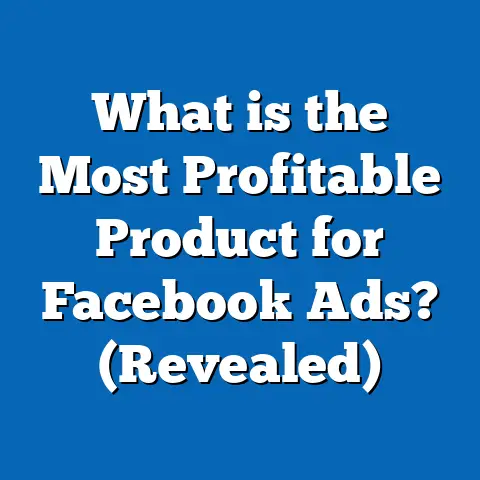What is a Good CPA for Facebook Ads? (Unlock Profit Potential)
Introduction: The Rising Significance of CPA in Facebook Advertising
Digital advertising has become a cornerstone for businesses aiming to reach the right audience at scale. Among the myriad platforms available, Facebook remains one of the most potent tools for marketers worldwide. However, as advertising budgets grow more competitive and consumers become more selective, knowing how to evaluate the true cost of acquiring a customer through Facebook ads is critical.
Cost Per Acquisition (CPA) is the metric that ties ad spend directly to business results. Unlike clicks or impressions, CPA measures how much it costs you to get a real conversion—whether that’s a sale, signup, or lead. With Facebook’s evolving ad ecosystem and recent privacy changes such as Apple’s iOS updates affecting tracking, advertisers face challenges in maintaining efficient CPA levels.
Industry data shows that while average CPAs have risen in recent years, savvy advertisers using advanced tools and strategies continue to unlock significant profit potential. For example, WordStream’s 2024 benchmarks reveal that the average Facebook CPA across all industries is approximately $18.68 but varies widely by sector. Top-tier campaigns regularly achieve CPAs under $10, demonstrating that with the right approach, Facebook advertising can be both effective and profitable.
This guide will explore what makes a good CPA on Facebook, backed by data, case studies, and actionable strategies. Whether you’re a marketing professional or business owner, you’ll gain practical insights to optimize your campaigns for maximum profitability.
Understanding CPA in Facebook Advertising
What is CPA?
Cost Per Acquisition (CPA) refers to the average amount you spend to convert a user into a customer or lead. It is a fundamental metric used to evaluate the financial efficiency of an advertising campaign.
Types of Acquisitions Measured by CPA:
- Product purchases
- Email newsletter signups
- App installs
- Form completions (e.g., contact forms)
- Phone calls initiated
Each campaign may define its acquisition differently depending on business goals.
Why CPA Matters More Than Other Metrics
While metrics like impressions, clicks, and click-through rates indicate engagement levels, they don’t directly measure business profitability. A campaign with high clicks but no purchases may waste budget.
CPA focuses on conversions that impact your bottom line. For example:
- An ad with 1,000 clicks at $0.50 CPC costs $500 but if only 5 users convert, CPA = $100 — likely unprofitable for most businesses.
- A campaign costing $300 with 30 conversions has a CPA of $10 — more efficient and potentially profitable.
This direct link between spend and outcome makes CPA indispensable for decision-making.
How Facebook Reports CPA
Facebook Ads Manager provides CPA metrics based on selected conversion events tracked via Pixel or Conversion API. You can customize attribution windows (e.g., 1-day click, 7-day view) influencing reported CPAs.
Industry Benchmarks: What is a Good CPA?
Average CPAs by Industry
CPA varies greatly by industry due to differences in product complexity, price points, and consumer behavior. Here’s an updated table with typical CPAs according to AdEspresso’s 2024 report:
| Industry | Average CPA Range (USD) | Notes |
|---|---|---|
| E-commerce | $10 – $30 | Lower ticket items see lower CPAs |
| Finance | $40 – $120 | High customer value justifies higher CPAs |
| Education | $25 – $50 | Depends on course price and funnel length |
| Health & Fitness | $20 – $60 | Often includes subscriptions and trials |
| B2B Services | $50 – $150 | Longer sales cycles increase CPA |
| Real Estate | $50 – $200 | High-value sales justify higher CPAs |
| Travel & Tourism | $30 – $70 | Seasonal fluctuations affect costs |
Key Takeaway: What Is “Good”?
A “good” CPA is always contextual:
- If your product sells for $100 with a 50% margin ($50 gross profit), then a CPA of less than $50 is necessary for profitability.
- For subscription models with recurring revenue, you can afford higher CPAs initially.
- For low-margin products (e.g., $15 profit per sale), aim for CPAs under $10.
Understanding your unit economics is essential before deciding what CPA to target.
Factors Influencing Facebook CPA
1. Product Price and Margins
Higher-priced products allow for higher CPAs while remaining profitable. For example:
- Luxury goods priced at $500+ often have CPAs above $50.
- Low-ticket items priced below $30 require CPAs well under $20.
Margin percentage also affects acceptable CPA.
2. Audience Targeting
Precise targeting reduces wasted ad spend:
- Broad targeting may increase reach but raise CPA due to irrelevant clicks.
- Custom Audiences from existing customers or warm leads tend to have much lower CPAs.
- Lookalike Audiences can help scale results while keeping CPAs reasonable.
3. Competition and Auction Dynamics
More competition in your niche increases bid prices:
- Highly competitive sectors like finance and insurance often see higher CPAs.
- Seasonal demand spikes (e.g., holidays) can temporarily increase costs.
4. Funnel Complexity
Longer funnels with multiple touchpoints often mean higher CPAs but potentially better-quality leads or customers.
5. Platform Changes and Privacy Regulations
Privacy updates like Apple’s App Tracking Transparency (ATT) impact tracking accuracy and targeting precision, increasing CPAs for some advertisers.
Detailed Data Analysis: Trends in Facebook CPA Over Time
Increasing Costs Over Recent Years
Industry data reveals steady increases in Facebook ad costs:
- Between 2018 and 2023, average Facebook CPC rose by approximately 35%.
- Average CPA increased by roughly 20% in the same period.
This is driven by:
- More advertisers competing for limited inventory
- Stricter privacy controls reducing targeting effectiveness
- Inflation impacting marketing budgets
Impact of iOS Updates on CPA
Apple’s iOS14 update introduced mandatory user consent for tracking apps across websites and apps, limiting data available to advertisers.
Results:
- Reduced pixel accuracy leads to delayed or fewer attributed conversions.
- Marketers report CPAs increasing by an average of 10-15% post-update.
- Advertisers who quickly implemented Conversions API experienced less impact.
Automation and AI Lowering CPA
Conversely, Facebook’s investment in AI-driven campaign optimization tools helps reduce CPAs when used correctly.
Examples:
- Automated bidding adjusts bids in real-time to maximize conversions at lowest cost.
- Campaign Budget Optimization (CBO) redistributes budgets efficiently across ad sets.
Case Study: E-Commerce Brand Cuts CPA by 35%
Company: FitGear (Fitness apparel e-commerce)
Initial Situation:
- Average CPA: $28
- Monthly ad spend: $15,000
- Conversion rate: 2%
Actions Taken:
- Implemented Facebook Conversions API for better tracking accuracy.
- Created segmented Custom Audiences based on browsing behavior.
- Used dynamic product ads for personalized retargeting.
- Adopted automated bidding with Cost Cap strategy.
- Optimized landing pages for mobile speed and clarity.
Results After 3 Months:
- New average CPA: $18.20 (35% reduction)
- Conversion rate increased to 3%
- Revenue increased by 40% at the same ad spend level
This demonstrates how combining technology with targeted strategy drives profit improvements.
How to Calculate Your Own CPA on Facebook Ads
Simple Formula
CPA=Total Ad SpendNumber of ConversionsCPA = \frac{\text{Total Ad Spend}}{\text{Number of Conversions}}
Example: Spending $1,000 resulting in 50 purchases gives: CPA=100050=20 USDCPA = \frac{1000}{50} = 20 \text{ USD}
Important Considerations:
- Ensure conversion tracking is correctly set up via Pixel or API.
- Choose an appropriate attribution window (e.g., 7-day click, 1-day view).
- Account for offline conversions if applicable (e.g., phone sales).
Tools to Help Measure CPA
- Facebook Ads Manager conversion reports
- Google Analytics conversion tracking
- CRM systems integrated with ad platforms
- Third-party attribution software (e.g., Adjust, AppsFlyer)
Strategies to Achieve a Good CPA on Facebook
1. Refine Audience Targeting
Why: Avoid wasting budget on uninterested users.
How:
- Use Custom Audiences from website visitors or email lists.
- Build Lookalike Audiences from high-value customers.
- Exclude irrelevant demographics or past converters.
- Narrow interests to highly specific behaviors related to your product.
Pro Tip: Layer targeting options (e.g., interest + behavior + demographics) for better precision.
2. Optimize Ad Creative and Copywriting
Why: Engaging ads increase conversion likelihood.
How:
- Test multiple image/video formats.
- Use clear CTAs aligned with the conversion goal.
- Highlight benefits over features.
- Use social proof like testimonials or reviews.
- Keep messaging consistent from ad to landing page.
Example: A study by Facebook found video ads reduce CPAs by an average of 30% compared to images in certain verticals.
3. Leverage Facebook Automated Bidding Strategies
Facebook offers several bidding options:
| Bidding Type | Description | When to Use |
|---|---|---|
| Lowest Cost | Finds cheapest conversions | For beginners or scalable campaigns |
| Cost Cap | Sets max CPA while maximizing volume | When you want predictable costs |
| Bid Cap | Caps bid on auctions | When controlling max bid amount |
Test which works best via split testing campaigns.
4. Implement Retargeting Campaigns
Retarget warm audiences who showed interest but didn’t convert:
- Website visitors who browsed product pages
- Cart abandoners
- Past purchasers for upsells/cross-sells
Dynamic ads showing products users viewed boost relevance and conversion rates.
5. Optimize Landing Pages
Poor landing pages cause high bounce rates increasing overall CPA:
- Ensure fast load times (under 3 seconds).
- Mobile-friendly design is critical since over 90% of Facebook traffic is mobile.
- Clear value proposition matching ad copy.
- Simple forms or checkout process.
- Include trust signals like reviews or guarantees.
Advanced Techniques to Lower Your CPA Even Further
Campaign Budget Optimization (CBO)
CBO lets Facebook automatically allocate budget among ad sets for best performance based on real-time data.
Benefits:
- Reduces manual budget adjustments
- Helps maintain lower overall CPA
A/B Testing for Continuous Improvement
Test variables such as:
- Headlines and primary text
- Images vs videos
- Audience segments
- Landing page elements
Use data from tests to refine campaigns continuously.
Use Video Ads Effectively
Video ads engage users better than static images:
- Short videos (<15 seconds) perform best.
- Show product benefits quickly.
- Include captions as many watch without sound.
Focus on Mobile Experience
Since the majority of Facebook users are mobile-first:
- Use vertical video formats optimized for mobile.
- Ensure landing pages are responsive.
- Simplify checkout forms for mobile ease.
Comparing Facebook CPA With Other Advertising Platforms
Understanding where Facebook stands helps set realistic expectations and decide channel mix.
| Platform | Average CPA Range (USD) | Strengths | Weaknesses |
|---|---|---|---|
| Facebook Ads | $10 – $50 | Detailed targeting; large audience | Increasing competition; privacy impacts |
| Google Ads | $30 – $70 | High intent search traffic | Higher cost per conversion |
| Instagram Ads | Similar to Facebook | Visual storytelling; younger audience | Similar privacy challenges |
| LinkedIn Ads | $50 – $150 | B2B targeting & lead gen | Expensive; smaller audience |
| TikTok Ads | $5 – $25 | Fast-growing; younger demographic | Less mature ad platform |
Facebook balances cost-effectiveness with reach and targeting precision better than many alternatives.
In-depth Case Study: SaaS Company Cuts CPA From $120 to $72
Company: TechFlow Software (B2B SaaS)
Problem: High cost per free trial signup ($120), limiting growth potential.
Approach:
- Created segmented Custom Audiences from website visitors and webinar attendees.
- Used Cost Cap bidding strategy for better cost control.
- Retargeted free trial signups with upgrade offers.
- Incorporated user testimonials in creative ads.
- Optimized landing page with clearer CTA and fewer form fields.
Outcome:
| Metric | Before Optimization | After Optimization |
|---|---|---|
| Average CPA | $120 | $72 |
| Conversion Volume | Baseline | +25% |
| ROAS | Low | Significantly Improved |
This comprehensive strategy shows how layered improvements help reduce CPA substantially in competitive B2B markets.
Monitoring and Adjusting Your Campaigns for Optimal CPA
Key Metrics To Track Alongside CPA
Tracking only CPA misses important insights:
- ROAS (Return On Ad Spend): Revenue generated per dollar spent
- CTR (Click Through Rate): Measures engagement quality
- Conversion Rate: % of clicks turning into acquisitions
- Frequency: How often your audience sees your ad (too high can cause fatigue)
Tools For Real-Time Monitoring
Facebook Ads Manager allows setting custom alerts based on performance thresholds such as rising CPA or dropping ROAS to react quickly.
Best Practices Summary: How To Consistently Achieve Good CPAs on Facebook
- Know Your Unit Economics: Understand your margins and CLV before setting CPA goals.
- Track Conversions Accurately: Use Pixel & Conversions API for reliable data.
- Segment Your Audience: Use Custom and Lookalike Audiences effectively.
- Test Creatives Regularly: Refresh ads to avoid fatigue and improve engagement.
- Use Automated Bidding Wisely: Experiment with Cost Cap or Lowest Cost bidding strategies.
- Retarget Warm Audiences: They convert at lower costs.
- Optimize Landing Pages: Mobile-first design with quick load times and simple CTAs.
- Leverage Data for Continuous Improvement: A/B testing & CBO help refine campaigns over time.
- Adapt to Platform Changes: Stay updated on privacy policies and new features like Advantage+ campaigns.
- Compare Platforms: Diversify channels while prioritizing those with best ROI.
Future Outlook: What’s Next for Facebook CPA Optimization?
Emerging Trends Impacting CPAs
- AI-Powered Personalization: Deeper machine learning will improve ad relevance leading to lower CPAs.
- Privacy-Centric Marketing: Solutions like aggregated event measurement will evolve but require adaptation.
- Video & Interactive Formats Growing: New creative types will boost engagement further reducing costs.
- Cross-platform Campaigns: Unified campaigns across Meta platforms will improve efficiency.
- Commerce Integrations: Direct shopping via Facebook Shops will shorten funnels reducing acquisition costs.
Marketers who stay ahead of these trends will maintain competitive CPAs and maximize profits.
Conclusion: Unlocking Your Profit Potential With Smart CPA Management
Understanding what makes a good CPA on Facebook isn’t about hitting arbitrary numbers—it’s about aligning your advertising costs with your business economics while adapting to market conditions and platform changes.
By mastering accurate measurement, refining targeting, continuously testing creatives, leveraging automation tools, and optimizing funnels end-to-end, marketers can consistently lower CPAs and unlock significant profit potential from their Facebook campaigns.
Start by benchmarking your current CPAs against industry standards, then apply the strategies outlined here systematically. Over time you’ll build campaigns that drive sustainable growth at efficient acquisition costs—turning every advertising dollar into measurable business success.
Appendix: Additional Resources for Mastering Facebook Advertising Metrics and Strategies
Online Courses & Certifications
- Facebook Blueprint – Official Meta training platform offers free courses on ad buying and measurement.
Industry Reports & Data Sources
Tools & Software Recommendations
- Facebook Ads Manager – Core campaign management & reporting tool
- Google Analytics – Cross-channel tracking integration
- Conversions API – Server-side event tracking solution
- Third-party attribution platforms: Adjust, AppsFlyer
Use these resources alongside this guide to deepen your understanding and sharpen your skills in managing Facebook ad campaigns profitably.
If you want me to break down any section further or add more detailed examples or technical explanations, let me know!

